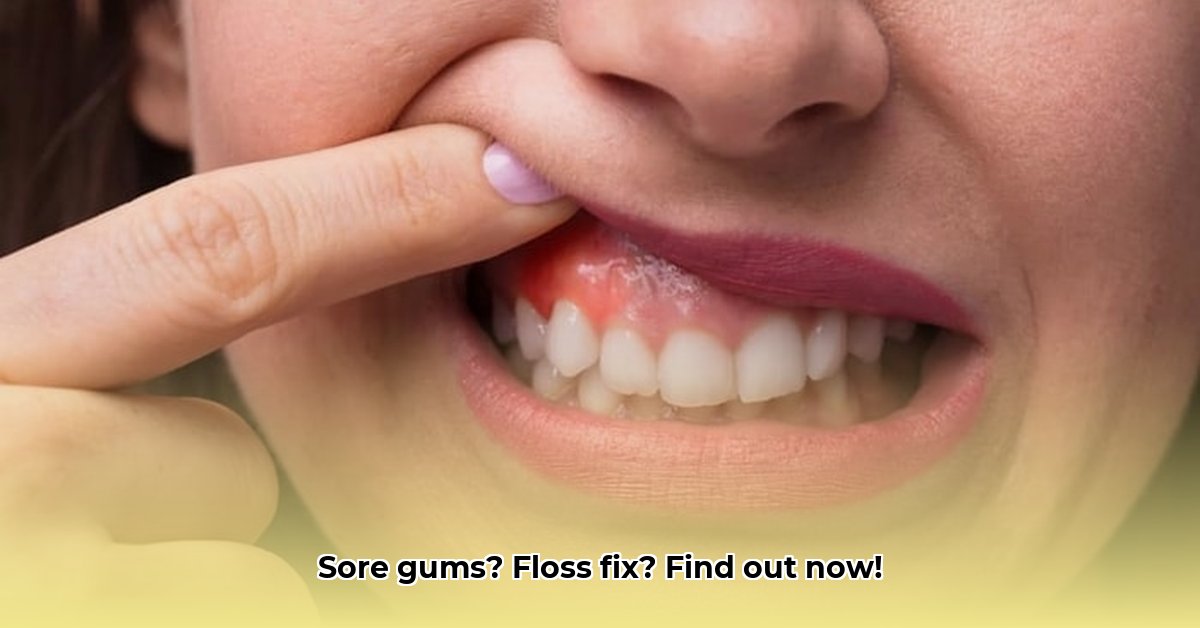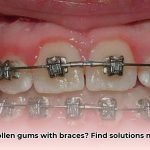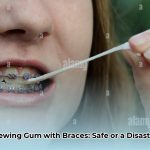Many people experience some gum tenderness after flossing, and it’s often nothing to worry about. However, persistent pain or discomfort signals that something needs attention. For more information on gum swelling, especially related to braces, see this helpful article: Braces and Gum Swelling. Let’s explore the common reasons why your gums might be hurting and what you can do to ease the pain and prevent future problems. This isn’t a replacement for professional dental advice, so always check in with your dentist if you have any concerns.
Why Are My Gums Sore After Flossing? Possible Causes and Solutions
Several factors can contribute to post-flossing gum pain, from improper technique to underlying gum health issues. Understanding these factors is crucial for effective gum pain relief.
- Flossing Technique: Aggressively sawing the floss back and forth between your teeth can irritate and injure your gums. Gentle, “C” shaped motions are preferable. Waxed floss helps reduce friction.
- Gingivitis (Early Gum Disease): Inflamed, swollen, and bleeding gums are characteristic of gingivitis, making them sensitive to flossing. The good news: gingivitis is usually reversible with proper oral hygiene.
- Periodontitis (Advanced Gum Disease): This more advanced form involves significant inflammation and potential damage to the tissues supporting your teeth, leading to pain, swelling, and potential tooth loss. Prompt dental intervention is essential.
- Other Dental Issues: A cracked tooth, a cavity, or even ill-fitting dental restorations can increase gum sensitivity, making flossing painful.
- Plaque and Tartar Buildup: Plaque, a bacterial film, hardens into tartar if not removed regularly. Both irritate the gums and contribute to gum disease.
- New to Flossing: If you’ve just started flossing, your gums might be adjusting! Initial tenderness is normal and should subside within a week or two.
Diagnosing the Problem: What’s Causing Your Gum Pain?
Consider these symptoms to help determine the likely cause of your gum sensitivity after flossing:
| Symptom | Possible Cause(s) | What to Do |
|---|---|---|
| Mild discomfort, slight bleeding | Improper flossing technique, early gingivitis, new to flossing | Adjust flossing technique. Use waxed floss. Maintain regular flossing. See your dentist if the problem persists. |
| Moderate pain, bleeding, swelling | Gingivitis, possibly early periodontitis | Schedule a dentist appointment for diagnosis and treatment advice. |
| Severe pain, persistent bleeding, swelling, pus, loose teeth | Periodontitis, possible infection, or another dental issue | Seek immediate dental attention. This suggests a more serious problem. |
Solutions and Remedies: Easing the Discomfort
The best approach depends on the cause of your gum pain. Here are actionable steps you can take:
-
Mastering the Art of Flossing:
- Gentle is Key: Clean each tooth individually, using a slow and deliberate “C” shaped motion with the floss. Avoid sawing.
- Waxed Floss: This may glide more easily between teeth, reducing friction.
- Fresh Floss: Use a new section of floss for each tooth to avoid spreading bacteria.
- Don’t Snap: Gently guide the floss between your teeth, avoiding snapping it against your gums.
-
Exploring Alternative Flossing Methods:
- Water Flossers: Use a pressurized stream of water to clean between teeth; gentler than traditional floss. Water flossers don’t fully replace traditional flossing, but are great complementary tools.
- Floss Picks: Small plastic tools with floss attached, which many people find easier to use. Consider floss picks with angled heads for reaching back teeth.
- Interdental Brushes: Small, cone-shaped brushes that fit between teeth to remove plaque.
-
Home Remedies (for Minor Irritation Only):
A warm saltwater rinse (1/2 teaspoon salt in 8 ounces of warm water) can temporarily soothe irritated gums. This is not a cure for gum disease.- Warm Compress: Apply a warm compress to the outside of your cheek near the affected area.
- Over-the-Counter Pain Relievers: Ibuprofen or acetaminophen can help manage pain.
-
When to See Your Dentist
Don’t delay a visit to the dentist if you experience:
- Persistent gum pain or bleeding that lasts for more than a few days
- Significant swelling or redness of your gums
- Pus or discharge from your gums
- Loose teeth
- Noticeable changes in your bite
- Pain localized to one tooth
Your dentist can accurately diagnose the problem and recommend the appropriate treatment
Preventing Future Gum Pain: A Long-Term Oral Hygiene Strategy
Reduce the chances of your gums hurting by adopting a proactive oral hygiene approach and making oral health a priority.
- Floss Daily: Using the correct technique to make flossing a daily habit.
- Brush Twice a Day: Brush gently with fluoride toothpaste for at least two minutes each time. Consider an electric toothbrush with a pressure sensor.
- Regular Dental Checkups: Checkups and professional cleanings every six months is optimal preventative care. Your dentist can also identify and address any underlying issues early on.
- Healthy Diet: Minimize sugary drinks and snacks, focusing on a balanced diet that supports overall health. A diet rich in Vitamin C and K contributes to healthy gums.
- Quit Smoking: Smoking significantly increases the risk of gum disease.
By consistently following these practices, you’ll significantly improve your oral health and reduce the risk of experiencing gum pain after flossing. According to the American Dental Association, consistent flossing can reduce the risk of gum disease by up to 40%. Remember, taking care of your gums is crucial for your overall well-being.
How to Fix Bleeding Gums After Flossing Gently
Key Takeaways:
- Bleeding gums after flossing are common, often indicating gingivitis or poor technique.
- Proper flossing technique is crucial to avoid injuring gums.
- Gentle flossing, combined with good brushing habits, reduces inflammation.
- Persistent bleeding warrants a dentist visit. Underlying health issues can impact gum health.
Understanding the Problem: What Causes Bleeding Gums?
So, your gums bleed after flossing? It’s more common than you think. Could you be flossing too aggressively, or might something else be going on? It is estimated that nearly half of adults experience bleeding gums at some point. Let’s explore the potential causes.
Common Culprits: Why are My Gums Bleeding?
- Poor Technique: The most common reason is aggressive sawing back and forth that injures your gums.
- Gingivitis (Gum Inflammation): Plaque buildup irritates the gums, leading to inflammation and bleeding.
- Periodontitis (Gum Disease): A more severe form of gum disease that involves infection and potential bone loss, requiring professional help.
- Other Dental Issues: Receding gums, cavities, or ill-fitting dental work can all contribute to bleeding.
- Underlying Health Conditions: Conditions like diabetes, hormonal changes (especially during pregnancy), or vitamin deficiencies can weaken gums, making them more prone to bleeding.
- Medications: Certain medications, like blood thinners, can increase bleeding.
Diagnosing the Issue: What’s Going On With Your Gums?
This simple guide helps you determine if you need professional help.
| Symptom | Likely Cause(s) | Next Step |
|---|---|---|
| Mild bleeding, resolves quickly | Improper flossing technique, mild gingivitis | Improve technique, increase flossing frequency |
| Persistent bleeding, swollen gums | Gingivitis, possibly periodontitis | See a dentist |
| Severe bleeding, pain, pus, loose teeth | Periodontitis, potentially serious infection | See a dentist immediately |
How to Fix Bleeding Gums After Flossing Gently: Step-by-Step Solutions
- Master the Floss: Use a gentle “C” shape around each tooth, avoiding aggressive sawing. Ensure you’re gently gliding the floss under the gumline.
- Embrace Alternatives: Water flossers or interdental brushes are gentler options. Remember these are often in addition to traditional flossing, not replacements. Studies show water flossers can be particularly effective at reducing gingivitis.
- Saltwater Rinse: Dissolve ½ teaspoon salt in 8 ounces warm water. Rinse gently twice daily for temporary relief only.
- Vitamin Boost: A balanced diet, rich in Vitamin C and K, supports gum health. Consider a supplement if you suspect a deficiency, but consult your doctor first.
- Check Your Medications: If you’re on blood thinners, discuss bleeding gums with your doctor.
- Professional Help: If bleeding persists, see your dentist for diagnosis and treatment recommendations. Early intervention is key to preventing periodontitis.
Preventing Future Problems
- Floss Daily: Make it a habit, like brushing your teeth.
- Gentle Brushing: Use
- Find Premium Personal Growth Clipart Now: Boost Your Content - October 19, 2025
- Unlock Your Potential: Top Personal Growth Blogs 2024 - October 16, 2025
- Discover Unforgettable Yachting Experiences for Personal Growth: Transform Your Life at Sea - October 14, 2025
















